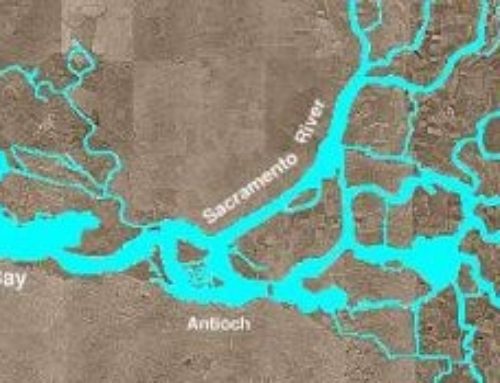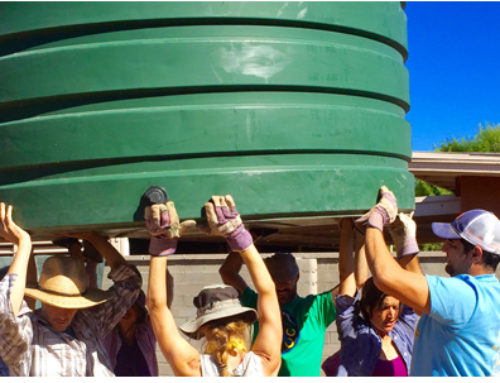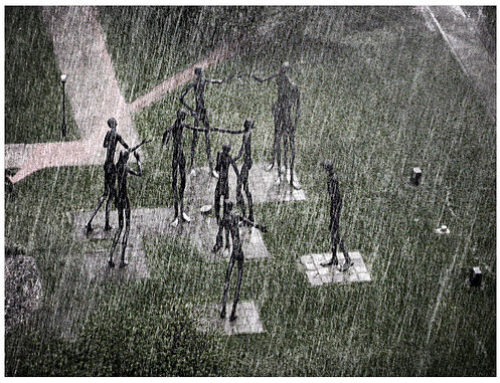-
At some point, you simply have to sit down and do the math to comprehend that growing development and population water demands are draining Lake Mead faster than it can be replenished. How will Southern Californians dependent on Colorado River supplies conserve their dwindling water resources?
Lowest Level for Lake Mead
In August 2010, Lake Mead reached its lowest level since 1956. Two images from the Thematic Mapper on the Landsat 5 satellite show some of the stark changes on the eastern end of the lake since 1985. The largest reservoir in the United States was straining from persistent drought and increasing human demand.
 Badger Cove, Driftwood Cove, and Grand Wash Bay have receded to become valleys and channels of the Colorado River, which flows in from the east. The shores around the lake display the “bathtub ring” effect, with a chalky white outline marking new shoreline where sediments had previously accumulated below the water.
Badger Cove, Driftwood Cove, and Grand Wash Bay have receded to become valleys and channels of the Colorado River, which flows in from the east. The shores around the lake display the “bathtub ring” effect, with a chalky white outline marking new shoreline where sediments had previously accumulated below the water.Located on the Colorado River, east of Las Vegas and west of the Grand Canyon, Lake Mead provides power and water for human activities in Nevada, Arizona, southern California, and northern Mexico. The reservoir grew up behind the Hoover Dam when it was built in the 1930s, and it can hold the equivalent of the entire flow of the Colorado River for two years.
The maximum capacity of Lake Mead is 28.5 million acre-feet (35 cubic kilometres) of water, with an acre-foot equalling the amount required to cover one acre to a depth of one foot. According to records from the U.S. Bureau of Reclamation, the lake held roughly 27.8 million acre-feet of water at its high point in 1941, and levels have fluctuated through drought in the 1950s and the filling of another upstream reservoir, Lake Powell, in the 1960s.
Lake levels rose steadily through the 1980s, reaching 24.8 million acre-feet in August 1985, when the left image was taken. But as of August 2010 (right image), Lake Mead held 10.35 million acre-feet, just 37 percent of the lake’s capacity.
Lake Mead reached its August 2010 low after decades of population growth in the American Southwest and twelve years of persistent drought. According to the U.S. National Park Service, the amount of water flowing out of and evaporating from Lake Mead has consistently exceeded the amount of incoming water in recent years.
Approximately 800,000 acre-feet evaporate yearly, and the water flow from the upstream reaches of the Colorado River has been far below normal since the start of the drought in 1998. Refilling the lake depends almost entirely (96 percent) on snowmelt from the Rocky Mountains and how much of that water is released from dams and reservoirs in the upper basin of the Colorado (Wyoming, Colorado, Utah, and New Mexico).
Whether climate change is involved or not, there is also a historical problem at work, as described by the National Park Service: “In 1922, the states of the Colorado River Basin created the Colorado River Compact, governing how the water of the river would be divided between them. They looked at the average flow of the Colorado River over a ten-year time period. Unknowingly, they chose ten years that had a higher annual flow of water. This overabundance caused them to overestimate the amount of water available.”
The Compact called for 16.5 million acre-feet to be allocated between the U.S. and Mexico, with another 0.6 million acre-feet lost to evaporation, for a total of 17.1 million. The actual average flow of the Colorado River is approximately 14 million acre-feet per year.
Another measure of the lake’s health is the lake level, or water elevation, which stood at 1,087 feet (331 meters) above sea level in late August 2010. Regional water management plans call for water restrictions to kick in when lake levels drop to 1,075 feet (328 meters). In August 1985, the lake level was 1,213 feet (370 meters).
The National Park Service notes that fluctuations in lake levels also affect recreational users of the lake and the businesses and facilities along the shore. A 20-foot drop in lake level translates to approximately a 600-foot move in the shoreline along some areas of the lake.






